Choosing endpoint management software doesn't have to be hard. In plain words, these tools help your IT team see every device, keep them up to date, and lock them down when something looks risky. If your people use laptops, phones, or tablets—at home or in the office—you need a simple way to manage them all from one place.
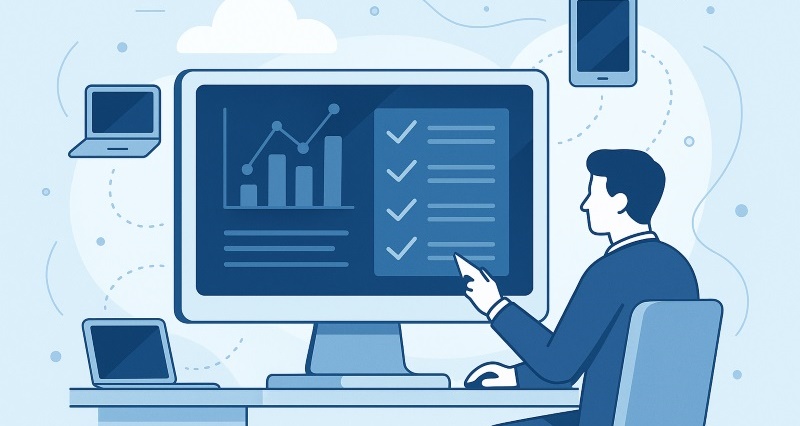
In 2025, keeping company devices safe and running smoothly is harder than ever. Desktops, laptops, phones and tablets connect from offices, homes and coffee shops. As an IT manager or business owner, you need a way to see what's happening across every endpoint, install updates quickly and stop data leaks before they happen. That's where endpoint management software comes in.
This guide breaks down what endpoint management software does, compares five of the top options for 2025 and gives straightforward tips on choosing the right tool. I've used plain language and real‑world examples so anyone—from busy managers to IT newcomers—can understand how these solutions work.
What is Endpoint Management Software?
Endpoint management software helps IT teams manage and secure all the devices (or endpoints) that connect to a company's network. Endpoints include computers, mobile phones, tablets, printers and even IoT devices. Good endpoint management tools do three main things:
- Inventory and control devices: They keep track of every device, its hardware details and what software is installed. You can push configuration policies, set up secure passwords, enforce encryption and remove unauthorized apps.
- Keep systems up to date: These platforms deploy patches and updates automatically. For example, if a new security update for Windows or macOS is released, the tool will test it and then install it on all company machines.
- Protect against threats: They set security policies (like requiring passcodes), block risky network connections and give administrators ways to lock or wipe lost devices. Many tools also include reporting that shows compliance with company policies or industry regulations.
Why does this matter? Managing devices manually is time‑consuming and error‑prone. Without automated patching, outdated machines could leave your network exposed. And if you're supporting remote or hybrid workers, you need a way to help them without asking for their device on your desk.
Top 5 Endpoint Management Software Compared
Below is a quick snapshot of five leading endpoint management tools for 2025. I've highlighted each product's key features, approximate pricing and user ratings to help you see how they stack up.
Microsoft Intune
What is Microsoft Intune
Intune is Microsoft's flagship unified endpoint management solution. It's designed for organizations already using Microsoft 365 and Azure. Intune manages desktops, laptops and mobile devices across Windows, macOS, iOS, Android and Linux. The tool integrates deeply with Azure Active Directory, letting you enforce conditional access and multi‑factor authentication. You can automate deployment of operating systems with Autopilot, push apps, and remotely lock or wipe a lost device. For example, a healthcare provider can ensure doctors' iPads are encrypted and only approved apps can access patient data.
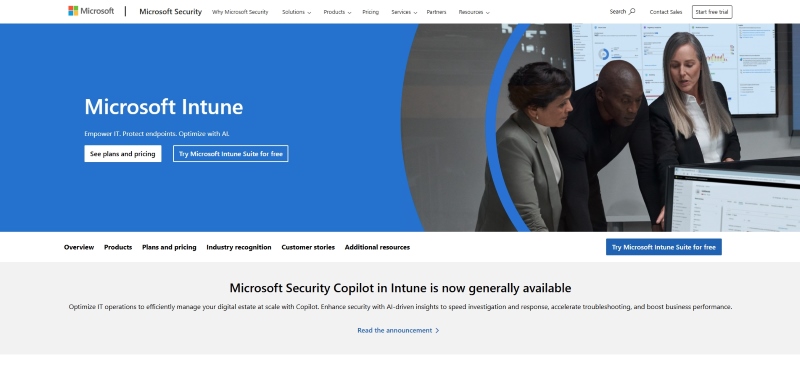
Key features
Intune's features include device enrollment (auto‑deploying settings and certificates), policy automation (for updates and security configurations), application management (installing, updating or blocking apps), compliance reporting and remote assistance. The Intune Suite also adds remote help, endpoint privilege management and a VPN‑like tunnel for secure app access. Because it is cloud‑based, you can manage devices anywhere with an internet connection.
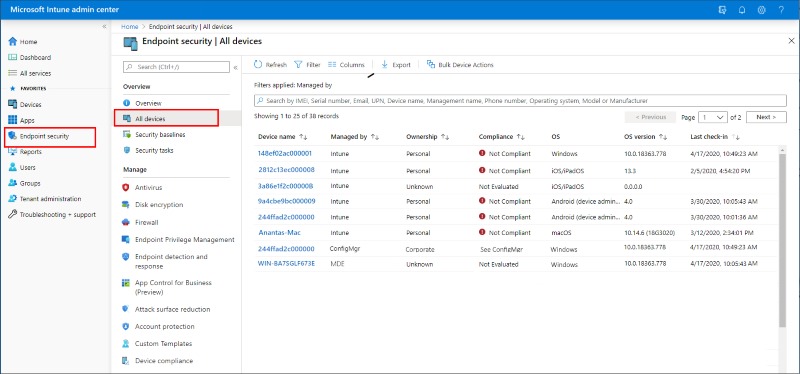
User experience
Users say Intune's web‑based admin console is straightforward once you understand Microsoft's ecosystem. It offers a self‑service portal where employees can install approved apps themselves. Since it works through Azure, you don't need on‑premises servers. However, small teams sometimes find the learning curve steep and the platform can feel complex if you're not familiar with Microsoft products. Reliable internet is a must because everything runs in the cloud.
 Pros:
Pros:
- Cross‑platform management covering Windows, macOS, iOS, Android and Linux.
- Seamless integration with Microsoft 365 and Azure AD for identity and access control.
- Strong security features like conditional access, compliance policies and integration with Microsoft Defender.
- Self‑service portal reduces IT workload.
- Scales easily for growing organizations.
 Cons:
Cons:
- Requires a stable internet connection; offline or local network management isn't supported.
- Limited support for some third‑party services and complex integrations.
- Advanced configurations may need experienced administrators and training.
- Pricing can add up when layering Plan 2 and the Suite, especially for large user bases.
AnySecura
What is AnySecura
AnySecura positions itself as an all‑in‑one endpoint management and data loss prevention (DLP) solution. Unlike general-purpose tools, AnySecura focuses on preventing data breaches and controlling how sensitive information moves. It's well suited for industries with strict compliance requirements—finance, healthcare, education—where preventing leaks is as important as patching software.

✨ Key features
AnySecura's core modules include:
- ✅ Device control: Manage and monitor every device connected to your network. You can block unauthorized USB drives or printers and set granular permissions for each user.
- ✅ Print & removable media control: Track print jobs and control USB/external storage. The system can encrypt USB drives so data stays secure outside the office.
- ✅ Application control: Create allowlists and blocklists to prevent unauthorized software from running.
- ✅ Document control: Log file operations and user actions. This is crucial for forensic investigations and compliance audits.
- ✅ Network traffic control: Restrict IP addresses, ports and protocols to block suspicious connections. Detailed reports show who accessed which services and when.
- ✅ Centralized management: A unified console provides real‑time monitoring, patch deployment, asset inventory and policy enforcement across endpoints. It also supports remote work environments and hybrid deployments.
User experience
AnySecura is designed to minimize the time you spend switching between tools. IT admins can apply policies across Windows, macOS and mobile platforms from a single dashboard. In practice, this means you can block unapproved apps, push a patch and view USB usage reports without opening multiple programs. For non‑technical managers, the interface uses clear dashboards and plain-language alerts. It's flexible enough to support remote work, education tablets or office desktops.
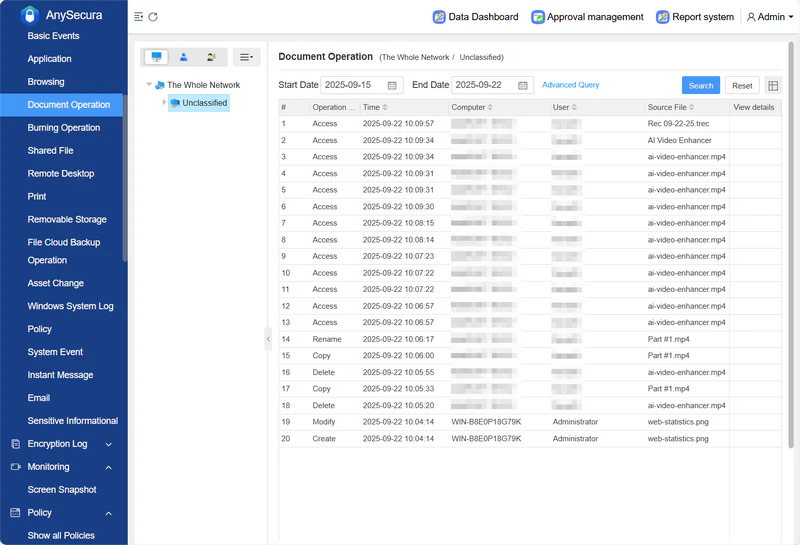
 Pros:
Pros:
- Deep data loss prevention: monitor document movements, print jobs and external storage to catch leaks early.
- Comprehensive device, application and network controls in one platform.
- Strong support for remote work and education devices.
- Simple, centralized console reduces administrative overhead.
- Flexible deployment options (cloud, on‑premises or hybrid) to fit different security policies.
 Cons:
Cons:
- As a specialized platform, AnySecura may integrate less seamlessly with third‑party productivity tools compared with generic UEM solutions.
VMware Workspace ONE
What is VMware Workspace ONE
VMware Workspace ONE targets enterprises that need a zero‑trust approach to endpoint management. It handles mobile, desktop and IoT devices under one umbrella and is popular among companies already using VMware virtualization. Workspace ONE offers conditional access based on device health and user context, integrates with virtual desktops and provides analytics for user experience monitoring.
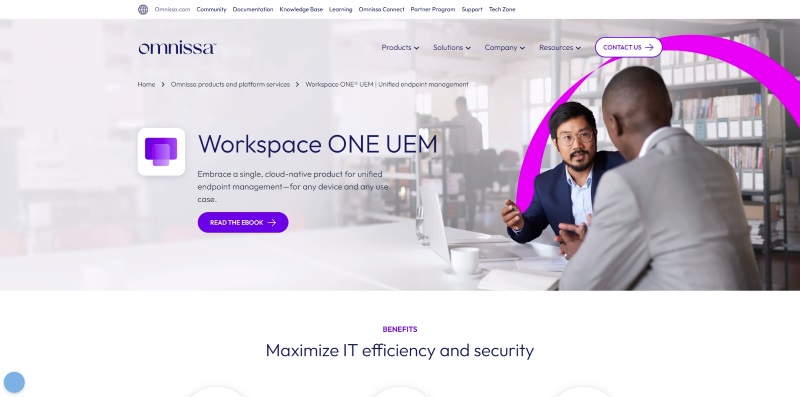
Key features
The platform supports unified endpoint management (UEM) across iOS, Android, Windows, macOS and even specialized devices. It includes app provisioning, remote access, geofencing, conditional access policies and risk analytics. The Enterprise edition adds orchestration, automation and risk scoring to prioritize vulnerabilities.
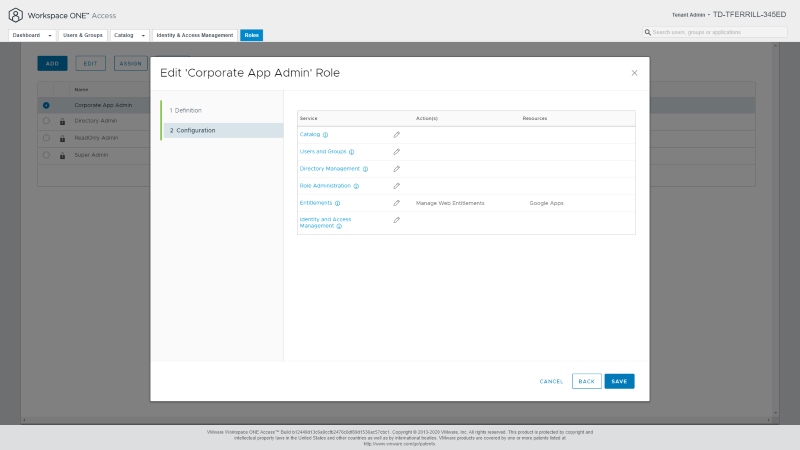
User experience
Users praise Workspace ONE for allowing secure access to company apps from anywhere and for its robust mobile integration. It consolidates many apps into a single portal, which can improve productivity. However, some reviewers mention that the dashboard can feel cluttered and navigation is sometimes confusing. Integration with non‑VMware systems may also be limited.
 Pros:
Pros:
- Unified management for mobile, desktop and IoT devices.
- Zero‑trust security model with conditional access and risk analytics.
- Deep integration with other VMware products and virtual desktops.
- Good end‑user experience: secure access to apps and data from anywhere.
 Cons:
Cons:
- Dashboard can be cluttered; features are buried in menus.
- Integration with other systems can be limited.
- Many features may be unnecessary for small teams, making the price feel high.
- Initial setup and maintenance often require dedicated IT staff.
ManageEngine Endpoint Central
What is ManageEngine Endpoint Central
ManageEngine Endpoint Central (formerly Desktop Central) is a long‑standing player aimed at organizations that want a broad set of endpoint management and security features at a relatively accessible price. It supports Windows, macOS, Linux, iOS and Android from a single console. The tool is available on‑premises or as a cloud‑hosted service.
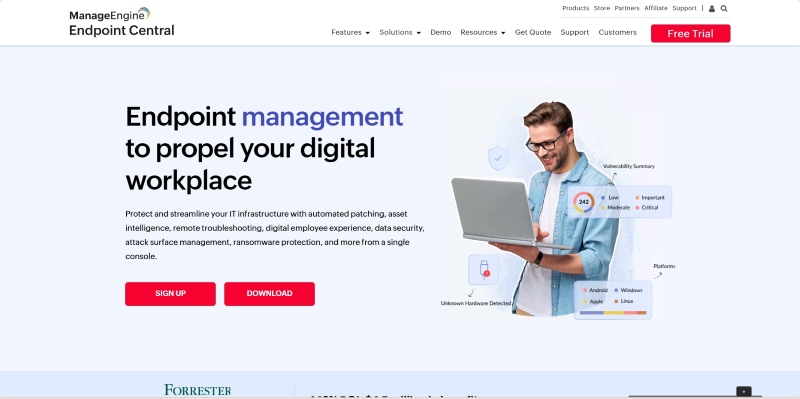
Key features
ManageEngine Endpoint Central's key modules include:
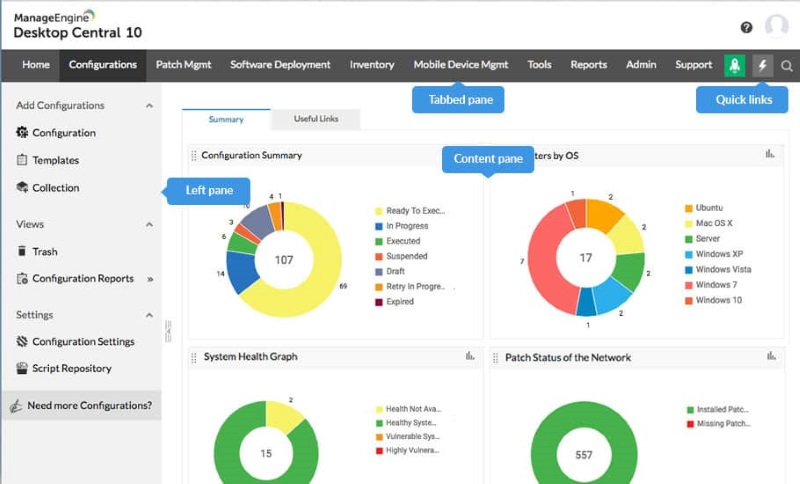

- Asset management with real‑time hardware/software inventory and web‑based reporting.
- Patch management for Windows and Linux, which detects, tests and deploys missing patches automatically.
- Software deployment using application templates and custom packages.
- Configurations and scripts to automate administrative tasks.
- Remote control via ActiveX/HTML5 for support and troubleshooting.
- Vulnerability assessment & remediation integrated into the console.
- Comprehensive reports for compliance and auditing.
User experience
ManageEngine is popular with IT admins because it offers a lot of functionality in one package. The dashboards provide a unified view of hardware, software and security status. However, some users note that customizing dashboards is limited and certain features are hidden in different menus, making them harder to find.
 Pros:
Pros:
- Unified management for Windows, macOS, Linux and mobile devices.
- Asset discovery, patching, OS deployment, security management and mobile device management in one console.
- Good value for money; the Professional edition starts around $795/year and the Security edition around $1,695/year.
- Suitable for academic institutions and organizations with diverse endpoint types.
 Cons:
Cons:
- Error messages aren't always clear when misconfigurations occur.
- Dashboard and report customization is limited.
- Some features require navigating through multiple tabs, which can slow down troubleshooting.
Ivanti Unified Endpoint Manager
What is Ivanti Unified Endpoint Manager
Ivanti Unified Endpoint Manager (formerly LANDesk) is built for enterprises needing centralized control across diverse devices—desktops, laptops, mobile devices and IoT. It can be deployed on‑premises or in the cloud. The focus is on automating patch management, enforcing security policies and managing applications.

Key features
Ivanti offers device management across Windows, macOS, iOS and Android; automated patch management; mobile device management; application lifecycle management; security and compliance enforcement and both cloud and on‑premises deployment options.
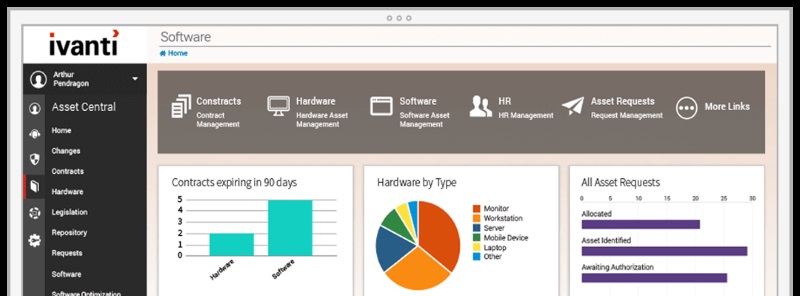
User experience
Large organizations appreciate Ivanti's scalability and ability to manage many device types. However, the interface is complex, and training is often required to use it effectively. The platform may integrate poorly with other systems, as one reviewer noted difficulties integrating with existing tools. Pricing is generally customized and may be high for small businesses.
 Pros:
Pros:
- Comprehensive management for multiple device types in one console.
- Scalable solution suitable for large enterprises.
- Flexible deployment: choose cloud or on‑premises.
 Cons:
Cons:
- Complex user interface requiring specialized training.
- Pricing isn't transparent and can be high for small budgets.
- Limited integrations and a learning curve, as noted in user reviews.
How to Choose the Right Endpoint Management Software?
Selecting the right tool doesn’t have to be overwhelming. Use the following criteria to narrow down your options:
- Company size and device diversity: Small businesses with a handful of devices may not need the enterprise‑level capabilities (and cost) of Ivanti or Workspace ONE. ManageEngine or AnySecura could be more cost‑effective. Large enterprises with hundreds or thousands of endpoints—including IoT devices—should look at Intune, Workspace ONE or Ivanti for scalability and robust security.
- Operating systems and platforms: If your environment is mainly Windows and you already use Microsoft 365, Intune integrates seamlessly. For mixed environments (Windows, macOS, Linux, mobile), ManageEngine or Ivanti provide broad coverage. AnySecura focuses on Windows and mobile devices with strong DLP. VMware Workspace ONE is ideal if you already use VMware’s virtualization ecosystem.
- Security and compliance needs: Organizations in regulated industries (finance, healthcare, education) should prioritize tools with advanced data loss prevention and granular policy control. AnySecura shines here with its print, document and USB control. Intune and Workspace ONE offer strong conditional access and integrate with threat defense services.
- Ease of use vs. depth of features: Consider your team’s expertise. Ivanti and Workspace ONE provide deep customization but require training and dedicated IT staff. Intune can be complex for newcomers but is intuitive if you’re familiar with Microsoft products. ManageEngine strikes a balance between features and usability. AnySecura is straightforward, with a single console focusing on data security.
- Budget: Look at both the upfront cost and ongoing subscription fees. ManageEngine’s annual pricing can be attractive for mid‑sized companies. Intune’s per‑user model scales well but can become expensive with add‑ons. Workspace ONE is priced per user or device and may be costly for small teams. AnySecura’s pricing is customized; contact sales to tailor the package to your needs.
By weighing these factors—size, platform diversity, security requirements, ease of use and budget—you can quickly narrow the field. Don’t forget to test products through free trials before committing.
FAQs about Endpoint Management Software
Q1 What is endpoint management software used for?
It helps IT departments manage and secure all company devices from a central place. With an endpoint management tool, you can automatically install updates, enforce security policies, track hardware and software assets, and lock or wipe a device if it’s lost. This reduces the risk of data breaches and saves time compared with manual updates and troubleshooting.
Q2 How do I choose the best tool for my business?
Start by listing your must‑have features—supported operating systems, security controls and reporting. Think about the number of devices you manage and your IT team’s skill level. Compare pricing models and look for free trials. Consider whether you need advanced data loss prevention (AnySecura), seamless Microsoft integration (Intune), a zero‑trust model (Workspace ONE), broad device coverage at a lower cost (ManageEngine) or enterprise‑grade scalability (Ivanti). Evaluate each tool against your budget and regulatory requirements and choose the one that meets your needs without overcomplicating your workflow.
Q3 Are these tools suitable for small businesses?
Yes, but some tools fit small businesses better than others. ManageEngine and AnySecura typically offer flexible licensing and easier deployment for smaller teams. Intune can work for small businesses that already use Microsoft 365, but costs may add up when adding advanced features. Workspace ONE and Ivanti are designed for larger enterprises and may be expensive or complex for small companies. Always try a demo first to see if the tool’s interface and pricing suit your organization.
Conclusion
Endpoint management software has become essential for protecting business data, supporting remote workers and keeping devices compliant. In 2025, there’s no one‑size‑fits‑all solution. Microsoft Intune offers excellent integration for Microsoft environments and flexible per‑user pricing. VMware Workspace ONE delivers powerful zero‑trust security and virtualization synergy, albeit at a higher cost. ManageEngine Endpoint Central balances features and affordability, making it a strong choice for mid‑sized teams. Ivanti provides scalable management for large enterprises but has a steep learning curve and bespoke pricing. Finally, AnySecura stands out for organizations that need rigorous data loss prevention on top of endpoint management—its device, print, document and network controls can prevent data leaks and support remote or hybrid work.
If safeguarding sensitive information and controlling how data moves are critical to your business, AnySecura deserves a close look. Its unified console and powerful DLP features offer peace of mind, even when employees work remotely. Ready to see how AnySecura can simplify your endpoint management and protect your data? .


